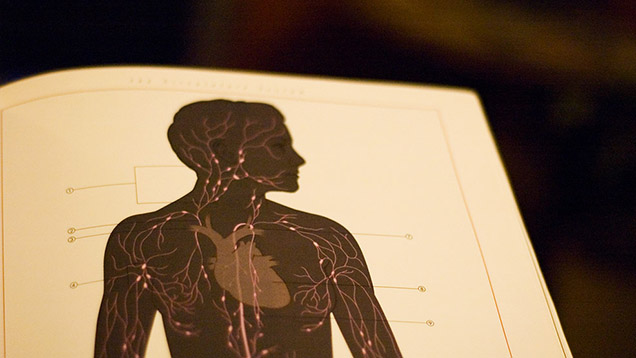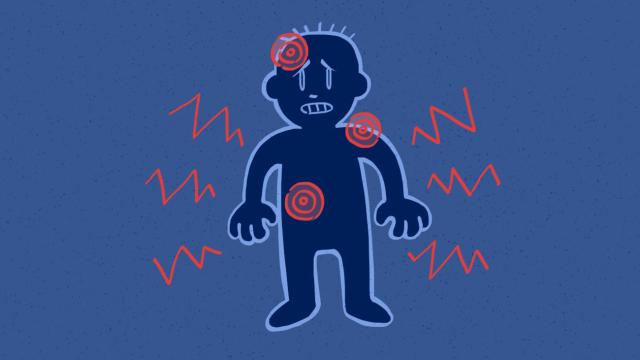Physical pain can be intimidating. Whether it’s a soreness after waking up, a sports injury or an unexpected twinge, pain can be scary if you aren’t mentally prepared to deal with it. We spoke to a few experts to learn how you can deal with — and prepare for — physical pain without feeling overwhelmed or freaked out.
Pictures: Tina Mailhot-Roberge, Bowy Gavid Bowie Chan, Nattu, Mandroid, Seattle Municipal Archives
Laugh to Keep From Crying

Sometimes distracting yourself from pain is the best way to tolerate it. Replace the emotions of turmoil, anxiety and despair with the complete opposite: humour. “Humour therapy” exists because humour and laughter have proven effects. A small set of studies, published by The Royal Society, discovered a correlation between social laughter and an elevated pain threshold. While the studies seem more exploratory than conclusive, the researchers tested this hypothesis through several different experiments. Lead researcher Robin Dunbar explains in an interview with The New York Times that “the causal sequence is laughter triggers endorphin activation.”
Ideally, you’d be laughing with other people or in a social setting (statistically speaking, you’re more likely to laugh in the presence of others — this study, published in Ethology, claims that you’re 30 times more likely to laugh with others than by yourself).
We approached physical therapist Jim Irvin (PT, MPT) for an expert’s opinion. When I spoke to him, he agreed, “Absolutely laughter and humour can help to reduce pain. It also provides a great endorphin release. It also takes the patient’s mind off of their pain.”
Try Relaxation and Visualisation Techniques

Even though you might roll your eyes at words like “relaxation” and “visualisation”, many patients have had some degree of success through them. For example, visualisation reduced chronic pain in this woman’s thumb. If your pain ever gets bad, and you’re waiting for the doctor or for treatment, put your scepticism aside and try a visualisation exercise. Even if it doesn’t remove the pain, at least it helps distract you from the pain.
There’s a school of pain management called “Mind Body Therapy” which consists of treatments that use the mind’s ability to affect the functions and symptoms of the body. You could try to relax with simple techniques like progressive muscle relaxation. We have some more tips to help you relax here. When you’re in pain, try breathing exercises. Many women use various breathing exercises to get through labour (which has been described as the worst type of pain — I wouldn’t know, but I wouldn’t doubt it). It’s possible you can better tolerate pain by modifying your breathing. Irwin recommends this simple breathing exercise to relax:
I like the 8-8-8 breathing technique. Breathe in for 8 counts, out for 8 counts, and repeat this process 8 times. This will usually decrease the tension in the body by improving oxygen flow to tissues and slow down neurotransmission (decreasing pain conduction).
New York University Langone Medical Center and Bellevue Hospital paediatrics resident Brian Steiner shares this story of how regular meditation affected a woman’s chronic pain in The Atlantic. Sometimes, mental exercises can alter the physical pain you’re facing.
Reduce Anxiety with Knowledge

Even physical pain is filtered through our mind, which is why mental techniques can influence it. Unfortunately, we can also overthink it. Pain can lead to fear and anxiety (“What’s causing this? Will it get worse?”). Anticipating pain can be just as bad — or worse — than actually feeling it.
A study published in PLOS showed that a lot of us prefer to get pain out of the way as soon as possible so we can avoid the dread and anticipation. When you’re in pain, do your best to dim anxiety and dread as much as possible. Remember the words of Mark Twain, “I’ve had a lot of worries in my life, most of which never happened.”
Here are some questions Irwin asks his patients to realistically assess their pain, which you can also use:
Well, for starters I find out the extent of their pain. How much is it limiting their daily routine? Are they doing anything that could be making it worse? I try to find out the extent of the injury before I can really educate them about their pain. In some instances, pain is a natural part of the healing process (especially after surgery). It is used as a protective mechanism. In the case of a broken leg, the pain will generally keep you from walking on it and doing further damage to it. So, if I can, I tell them that pain is normal.
If you’re feeling anxious, finding out more information about the pain can lessen the mystery of it. Primary care physician Dr Dan Weiswasser says:
Lack of understanding, which underlies much fear, can be addressed by education. I find that, when people know what to expect, an anticipated procedure is much less stressful and perhaps even less painful. As you well know, there’s a lot of misinformation on the web, so one has to choose sources carefully.
Weiswasser recommends sources such as WebMD and Mayo Clinic, as well as anything from the government. He also recommends sites such as familydoctor.org and aap.org. We’ve also looked at ways how to find accurate medical information online and medical websites that you can trust.
Be Patient and Wait for the Tincture of Time

Physical pain can drain you of hope. Even if you’re feeling overwhelmed, remember that your body can be surprisingly smart and resilient. It might be possible for your body to heal as time passes. Dr Weiswasser says:
I am also a big fan of “tincture of time”; our bodies have an amazing ability to heal themselves and many issues improve with time (although this can be a hard sell in a society used to fast results and immediate gratification).
Patience is the last thing in the world that comes to mind when you’re in pain, especially if it is taking over your life. Keep a little ray of hope alive, even just in the back of your mind. Remember, it’s possible that the tincture of time might alleviate your pain.
None of these techniques will make physical pain a walk in the park, but it might make things just a little more bearable. Distract your mind by laughing, and trying visualisation and relaxation techniques. Reduce your anxiety with knowledge, both by educating yourself and talking to healthcare providers. Stay hopeful and know that it’s possible for your body to heal itself with time.

Comments